“Our World is facing a refugee crisis of a magnitude not seen since the second World War. This presents us with great challenges and many hard decisions.” ~Pope Francis~
Non-Profit organizations have been established since nearly 80 years ago and are still prominent in today’s world. Refugee organizations such as the Lutheran Immigration and Refugee Service located in Baltimore, Maryland is constantly updating their website to target towards those who have a passion of giving back. The LIRS contains features that provide rhetorical messages including audience, purpose, context, author and genre to create a multimodal website.
The home page of the site begins with a view of the navigation bar which includes links to pages like “about us, our work, take action, resources, press room, blog and DONATE.” The donate button is bolded in bright orange (unlike the blue theme) on the top right corne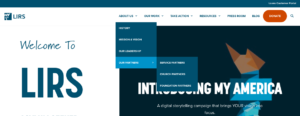 r. This indicates that the intended audience are people with money who can afford to donate. The website also provides a link that is called “our partners.” Our partners include the church partners that are affiliated with certain activities that the LIRS may provide. The donate button also serves a purpose for possible members of a church that works collaboratively with the LIRS. Members of the EvangelicalLutheran Church in America (ELCA), the Lutheran Church—Missouri Synod LCMS, and the Latvian Evangelical Lutheran Church in America (LELCA) could have a higher chance of donating because they are partnered with the LIRS.
r. This indicates that the intended audience are people with money who can afford to donate. The website also provides a link that is called “our partners.” Our partners include the church partners that are affiliated with certain activities that the LIRS may provide. The donate button also serves a purpose for possible members of a church that works collaboratively with the LIRS. Members of the EvangelicalLutheran Church in America (ELCA), the Lutheran Church—Missouri Synod LCMS, and the Latvian Evangelical Lutheran Church in America (LELCA) could have a higher chance of donating because they are partnered with the LIRS.
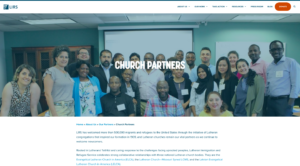
Since the LIRS is a religious focused non-profit, it is important to recognize that refugees who are seeking help may want to work with a lutheran-influenced asylum. The website tailors their focus on those who are religious by inserting a “history” page (underneath the “about us” category,) explaining that the LIRS
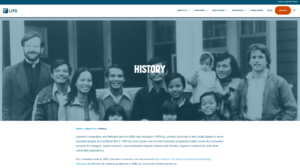 has a religious “tone” to the organization as a whole. Refugees and Immigrants who follow a specific religion may favor the fact that it is a Lutheran non profit, for they understand how churches give back to the community and would prefer to be affiliated with this influence. The purpose is to target a group of refugees and with appropriate resources, use them to provide a religious influence on their daily lives.
has a religious “tone” to the organization as a whole. Refugees and Immigrants who follow a specific religion may favor the fact that it is a Lutheran non profit, for they understand how churches give back to the community and would prefer to be affiliated with this influence. The purpose is to target a group of refugees and with appropriate resources, use them to provide a religious influence on their daily lives.
The overall intention of the Lutheran Immigration and Refugee Service is to create a religious focused home for refugees and for those who would like to work for a religious focused refugee organization. The LIRS provides a link called “steps to host a refugee Sunday” which shows how your Lutheran church can get involved in service. With programs such as “Refugee Sunday, Faith on the Move, Be not afraid, No Temas, and ELCA Youth Gatherings,” lutheran churches are encouraged to get involved with helping immigrants through the LIRS.
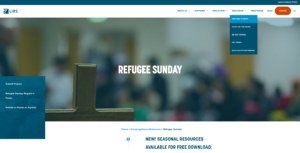
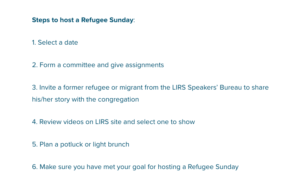
To target every time of demographic, the LIRS uses the internet web overall to capture their audience. They also use images on their website of the statue of liberty as their main theme and the flame in the statue of liberty as their logo to provide a feeling of full acceptance for the potential refugees. Like many non profit websites, the Lutheran Immigrant and Refugee Service website targets everybody. In this day of age, mostly everybody in the world ha s internet and technology, so for the LIRS to be using the web as their main source of interaction shows they are trying to reach a mass audience. In order to further reach a mass audience of all demographics, the website provides a tiled mosaic structure of a “digital storytelling campaign” to welcome fellow immigrants. The campaign consists of refugees who have previously gone through the LIRS proving the credibility and to shed a positive light on the program.
s internet and technology, so for the LIRS to be using the web as their main source of interaction shows they are trying to reach a mass audience. In order to further reach a mass audience of all demographics, the website provides a tiled mosaic structure of a “digital storytelling campaign” to welcome fellow immigrants. The campaign consists of refugees who have previously gone through the LIRS proving the credibility and to shed a positive light on the program.
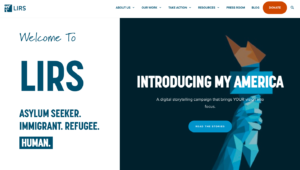
The LIRS does a good job with site exploration. Since there is no sound on the page or any type of video’s generalizing the LIRS, this forces viewers to explore their website a bit more and view other criteria other than the home page to get a feel for the site. Unlike other refugee sites such as the HIAS, the LIRS does not have a video testimony or audio media. Since viewers are forced to actually read the site a bit more, the LIRS provides postings to get viewers updated with recent news about refugees occurring in the United States. This further emphasizes how important refugee asylums are. The news postings include current events regarding the President of the United States, and LIRS updates.
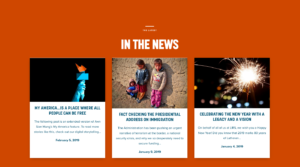
Since viewers are forced to explore the page to get more details, people who view this website would most likely access this on their computer, or their phones. The overall layout of the website creates an aesthetically pleasing appearance where viewers read from left to right. 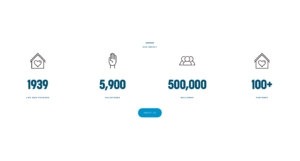 The overall facts that readers need to know are dead center, in large text, with no other distractions or information surrounding it. This is done purposefully so people can scroll and analyze the page with ease.
The overall facts that readers need to know are dead center, in large text, with no other distractions or information surrounding it. This is done purposefully so people can scroll and analyze the page with ease.
The previous author of the LIRS (who was president Linda Hartke, 2017) established the site’s credibility by saying that the non profit has been around for 80 plus years. This allows the readers to gain a sense of comfort since it has been established for a long time. With a quick google search, people who view the website could also see awards that the LIRS have received. The site provides an announcement that president, Linda Hartke has won the Maryland International Business Leadership award back in 2017. However, what the site does not mention is that in 2018, Hartke was soon fired as the LIRS CEO due to her “financial irregularities” and “harassment” during her time. This has caused her reputation to soon backfire.
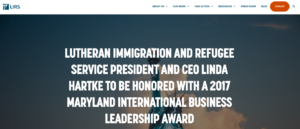

Overall, the site establishes it’s credibility by providing viewers a history page which states that the non-profit has been around since 1939. The LIRS also establishes their credibility by providing a “Loans Customer Portal” button at the top right corner, indicating that the organization has money to give out loans for potential refugees. The LIRS site categorizes as a non-profit refugee website that protects and helps refugees while being welcomed to the community. It is also categorized as a refugee site due to it’s options for asylum seekers as well as the common theme of “donations, ways to get involved, and our work” found on the main header navigation bars of each site. For example, a website called “Refugees International” looks almost identical to the LIRS website with its header options. Refugeesinternational.org creates news postings in a centered alignment as well, just like the Lutheran Immigrant and Refugee Services site however the only difference is that Refugee International categorizes their news as “The Latest from RI.”
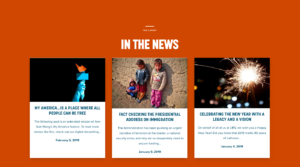 vs.
vs. 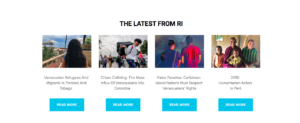
Overall, the Lutheran Immigrant and Refugee Services website is a well organized, aesthetically pleasing site with an abundance of information. The site provides positive multimodal tactics to grab viewers into providing or receiving help in many ways. The dark blue and light blue color scheme approach of the site comes off as a non-threatening way to getting involved with the LIRS. The overall alignment makes it easy to read and perfect for people with a slim vocabulary. Although the site is easy to navigate and skim, the creator of the site could have provided some auditory and more visual modes to then grab an even larger demographic. People who are blind could use the audio and people who have reading disabilities need the videos to grasp as much information as they can.
References:
“Lutheran Immigration and Refugee Service.” LIRS, 6 Feb. 2019, www.lirs.org/.
“Refugees International.” Refugees International, www.refugeesinternational.org/.
Corcoran, Ann. “Lutherans Announce Departure of CEO Hartke amid Claims of Financial Irregularities, Poor Management.” Refugee Resettlement Watch, 14 Feb. 2018, refugeeresettlementwatch.wordpress.com/2018/02/14/lutherans-announce-departure-of-ceo-hartke-amid-claims-of-financial-irregularities-poor-management/.